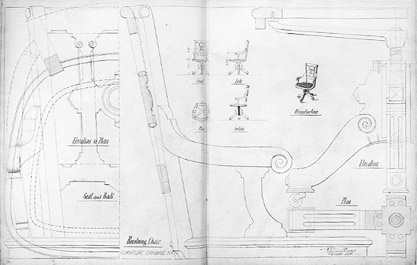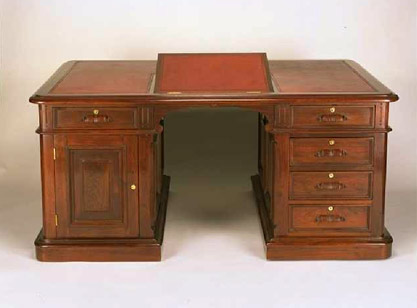Office of Mary Brooks, San Francisco Mint Director

Fortuitously, a significant number of pieces of furniture from the old San Francisco Mint have been accessioned into the Treasury collection and are housed in the Treasury building. This includes desks, lounges, upholstered and non-upholstered armchairs and side chairs, desk chairs, tables, umbrella stands and water cooler & umbrella stands, all of which are listed on the 1874 furniture schedule. It represents the largest group of furniture in the Treasury Collection from a Treasury bureau and first came to the Treasury building from Philadelphia in 1970 where it was discovered by the Director of the Mint, Mary Brooks, in 1969. According to an article in The ""Evening Star"" of July 15, 1970, “It had been shipped there in 1968 from San Francisco by the National Park Service which took custody of it when the General Services Administration took over the old U.S. Mint Building.” 22 The Mint Director had the furniture “restored,” and placed it in her Treasury office.
Judge's Chair from the San Francisco Mint

The “Judge’s Chair”, shown here was not tufted in a 1970 photograph of Director of the Mint's Mary Brook’s office. However, both the period photos and the architect’s drawing book show a fully tufted back and seat, the chairs have been conserved and are now similarly tufted in leather.
San Francisco Mint Lounge Chair, restored

In 1994, the San Francisco Mint building was closed and the Mint Museum disassembled. The original furniture was then “moth-balled,” until eventually some objects were shipped to the Mint headquarters in Washington. In 2001 the Mint transferred a major group of furniture to main Treasury. This was followed by the transfer in 2003-2004 of the remainder of the Mint Museum collection that was considered surplus. It has now been accessioned into the Treasury collection and conserved for use in the Treasury building’s offices.
Drawing of a revolving armchair for the San Francisco Mint

The drawings for an armchair and desk or “revolving” chair show a lack of upholstered tufting like the treatment designated for the Judge's and Lounge chairs.
Restored Revolving Chair from the San Francisco Mint

Examples of the revolving chair furniture design depicted in the sketchbook are represented in the Treasury collection with caned seats.
Restored San Francisco Mint Desk with Elevated Reading Stand

The San Francisco Mint inventory lists multiple desks and the surviving desks have been conserved for use in the Treasury collection. The desks have an elevated reading stand which is positioned directly above the kneehole. This feature has been uniformly restored as well, and was also an element that appears on the Harrington & Mills Baltimore prototype.
San Francisco Mint Work Table, restored

In addition to significant desks and chairs, a number of tables from the San Francisco Mint have survived and correspond to both the period photographs and drawings from the Mint. In conclusion, the Treasury’s San Francisco Mint furniture represents a significant collection of extremely well-documented 19th-century objects. This documentation not only opens a window into the process of creating and manufacturing the furniture, but also provides period information in the form of photographs and architectural drawings. Fortunately, the furniture has been accurately restored and conserved to its original appearance and continues to serve the Treasury Department in a setting similar to that for which it was originally intended, a building designed in part by the Office of the Supervising Architect under the supervision of Architect Alfred Mullett.
